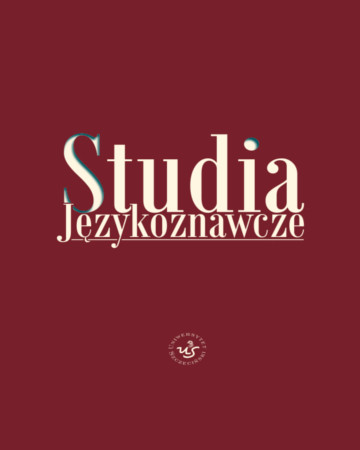





| Authors: |
Urszula
Chwesiuk

University of Szczecin, Szczecin |
| Keywords: | cross-linguistic influence phraseology translation lexical choice |
| Data publikacji całości: | 2021 |
| Page range: | 15 (5-19) |
| 1. | Balcom, Patricia. “Cross-linguistic influence of L2 English on middle constructions in L1 French”. In: Effects of the Second Language on the First, ed. Vivian Cook, 168–192. Clevedon, UK: Multilingual Matters, 2003. |
| 2. | Bloem, Ineke, Sylvia van den Bogaard, Wido La Heij. “Semantic facilitation and semantic interference in language production: Further evidence for the conceptual selection model of lexical access”. Journal of Memory and Language 51 (2004): 307–323. |
| 3. | Brown, Amanda, Marianne Gullberg. “Bidirectional crosslinguistic influence in L1–L2 encoding of manner in speech and gesture”. Studies in Second Language Acquisition 30 (2008), 2: 225–251. |
| 4. | Brown, H. Douglas. Principles of Language Learning and Teaching. New Jersey: Pearson Educated Limited, 2007. |
| 5. | Carroll, Mary, Monique Lambert. “Information structure in narratives and the role of grammaticised knowledge: A study of adult French and German learners of English”. Information structure and the dynamics of language acquisition. Amsterdam: Benjamins, 2003, 267–287. |
| 6. | Cook, Vivian. Effects of the Second Language on the First. Clevedon, UK: Multilingual Matters Publishing, 2003. |
| 7. | Cook, Vivian, Elisabet Iarossi, Nektarios Stellakis, Yuki Tokumaru. “Effects of the L2 on the syntactic processing of the L1”. In: Effects of the Second Language on the First, ed. Vivian Cook, 193–213. Clevedon, UK: Multilingual Matters, 2003. |
| 8. | Corder, Stephen P. “The significance of learners’ errors”. International Review of Applied Linguistics in Language Teaching 5 (1967): 161–170. |
| 9. | Cummins, Jim. “The Cross-Lingual Dimensions of Language Proficiency: Implications for Bilingual Education and the Optimal Age Issue”. TESOL Quarterly 14 (1980), 2: 175–187. |
| 10. | Cunningham, Thomas H., C. Ray Graham. “Increasing native English vocabulary recognition through Spanish immersion: Cognate transfer from foreign to first language”. Journal of Educational Psychology 92 (2000): 37–49. |
| 11. | Dong, Yanping, Shichun Gui, Brian Macwhinney. “Shared and separate meanings in the bilingual mental lexicon”. Bilingualism: Language and Cognition 8 (2005), 3: 221–238. |
| 12. | Dweik, Bader. “Lexical and Grammatical Interference in the Translation of Written Texts from Arabic into English”. Academic Research International 8 (2017), 3: 65–70. |
| 13. | Erarslan, Ali, Hol Devrim. “Language interference on English: Transfer on the vocabulary, tense and preposition use of freshmen Turkish EFL learners”. ELTA Journal 2 (2014), 2: 4–22. |
| 14. | Ewert, Anna, “Do they have different L1s? Bilinguals’ and monolinguals’ grammaticality judgements”. In: Two or more languages: Proceedings from the 9th Nordic Conference on Bilingualism, ed. A. Nikolaev, J. Niemi, 56–66. Studies in Languages 43. Joensuu: University of Joensuu, 2008. |
| 15. | Flege, James Emil, Wieke Eefting. “Cross-language switching in stop consonant production and perception by Dutch speakers of English”. Speech Communication 6 (1987): 185–202. |
| 16. | Havlaskova, Zuzana. Interference in Students’ Translation. Brno: Masaryk University, 2010. |
| 17. | Jarvis, Scott, Aneta Pavlenko. Cross-linguistic Influence in Language and Cognition. New York: Routledge, 2008. |
| 18. | Jarvis, Scott. “Probing the effects of the L2 on the L1: A case study”. In: Effects of the Second Language on the First, ed. Vivian Cook, 81–102. Clevedon, UK: Multilingual Matters, 2003. |
| 19. | Kecskes, Istvan. “L2 effect on L1 Babylonia”. The Swiss Journal of Language Learning 2 (2008), 8: 30–34. |
| 20. | Kecskes, Istvan, Tünde Papp. Foreign Language and Mother Tongue. Mahwah, NJ: Erlbaum, 2000. |
| 21. | Laufer, Batia. “The influence of L2 on L1 collocational knowledge and on L1 lexical diversity in free written expression”. In: Effects of the Second Language on the First, ed. Vivian Cook, 19-31. Clevedon, UK: Multilingual Matters, 2003. |
| 22. | Liu, Peiyun, Chuanbin Ni. “Effects of L2 on the L1 at Semantic Level: An Empirical Study”. Journal of Language Teaching and Research 7 (2016), 2: 425–431. |
| 23. | Newmark, Peter. A Textbook in Translation. Hertfordshire, Prentice Hall, 1988. |
| 24. | Odlin, Terence. “Crosslinguistic influence”. In: The Handbook of Second Language Acquisition, ed. C.J. Doughty, M.H. Long, 436–486. Oxford: Blackwell, 2003. |
| 25. | Olshtain, Elite. “Sociocultural competence and language transfer: The case of apologies”. In: Language Transfer in Language Learning, ed. S. Gass, L. Selinker, 232–249. Rowley, MA: Newbury House, 1983. |
| 26. | Pavlenko, Aneta. “’I feel clumsy speaking Russian’: L2 influence on L1 in narratives of Russian L2 users of English”. In: Effects of the Second Language on the First, ed. Vivian Cook, 32–61. Clevedon, UK: Multilingual Matters, 2003. |
| 27. | Pavlenko, Aneta, Scott Jarvis. “Bidirectional Transfer”. Applied Linguistics 23 (2002), 2: 190–214. |
| 28. | Pullum, Geoffrey. The Great Eskimo Vocabulary Hoax. Chicago: University of Chicago Press, 1991. |
| 29. | Pułaczewska, Hanna. “The influence of the acquisition of English as a foreign language on acceptability judgements in L1 Polish among young adults”. The Language Learning Journal (2020). |
| 30. | Ringbom, Håkan. “The influence of the mother tongue on the translation of lexical items”. Interlanguage Studies Bulletin 3 (1978): 80–101. |
| 31. | SattiHamad, Mohammed, Yassin Abdulla. “Investigating lexical errors and their effect on university students’ written performance in Sudan”. SUST Journal of Humanities 16 (2015), 1: 1–18. |
| 32. | Sunde, Anne Mette, Kristoffersen Martin. „Effects of English L2 on Norwegian L1”. Nordic Journal of Linguistics 41 (2018), 3: 275–307. |
| 33. | Yelland, Gregory W., Jacinta Pollard, Anthony Mercuri. “The metalinguistic benefits of limited contact with a second language”. Applied Psycholinguistics 14 (1993): 423–444. |
| 34. | Zabawa, Marcin. “Language contact, bilingualism and linguistic competence: the influence of L2 on L1 competence”. Linguistica Silesiana 33 (2012): 241–256. |